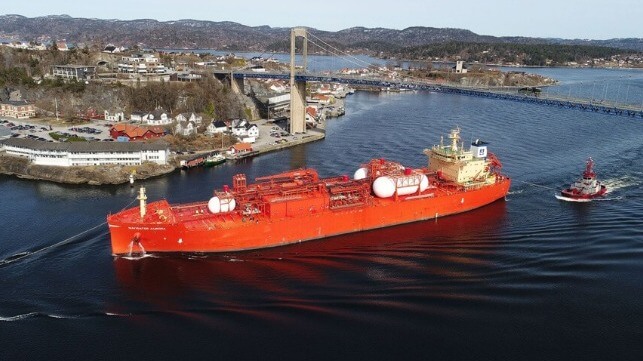Uniper to Work with Navigator Gas and Bumi Armada on CO2 Transport

Energy major Uniper is turning to a partnership between Navigator Gas and Bumi Armada as the next phase of a project to capture, recycle, and store CO2 emitted from one of the company’s UK-based power plants. Navigator and Bumi Armada last year announced a partnership to develop carbon transfer capabilities and now the companies are proposing a fleet of vessels as part of Uniper’s efforts.
Under an agreement signed with Uniper for its natural gas-powered Isle of Grain power plant, the Navigator Gas and Bumi Armada partnership known as Bluestreak CO2 will explore the feasibility of implementing a jetty-moored floating liquid CO2 storage facility which would support a fleet of liquid CO2 shuttle tankers. The vessels would be capable of loading from the facility and delivering the sequestered CO2 to either a floating carbon and storage unit or a unit that also has injection capability to send the CO2 into offshore storage aquifers and or depleted oil and gas reservoirs.
Bluestreak CO2 was first proposed a year ago as their entry into the emerging CO2 transport and storage market. The company looks to leverage Navigator Gas’ experience operating what it calls the world’s largest fleet of handysize liquified gas carriers. The fleet includes 56 gas carriers of which 25 are ethylene and ethane capable. Bumi Armada is a provider of floating infrastructure systems including offshore engineering facilities. It is also the operator of FPSOs.
The companies are saying they anticipate subject to board approval to formalize the Bluestreak CO2 joint venture by the end of 2024. They highlighted that the collaboration with Uniper will demonstrate how Bluestreak CO2 would be able to serve emitters with no access to pipeline infrastructure. They believe it will provide an effective tool in managing and storing CO2 emissions.
“Flexible CO2 transport solutions are needed to decarbonize essential industrial processes, which are not close to pipeline and subsea storage locations and will be critical to get first-of-a-kind non-pipeline projects like Grain Carbon Capture into operation,” said Uniper’s UK Country Chair Mike Lockett.
Grain is a power station in the Southern UK operating on the Isle of Grain in Kent since 2011. It has a capacity to generate 1,326 MW of power using natural gas. In February 2024, Uniper launched the next phase of exploration for a carbon capture project at the plant. They assigned projects to Technip Energies and Aker Carbon Capture competing to engineer the carbon capture system for Grain.
The companies are developing the technology required for CO2 capture, conditioning, liquefaction, and a temporary storage facility. Uniper is proposing to use post-combustion carbon capture technology on up to three units at Grain. They will evaluate the two companies’ proposals with the aim of selecting a preferred technology provider during FEED and other project stages. Uniper estimates it would be possible to remove over two million tonnes of CO2 per year during the electricity generation process. They expect to take a final investment decision by the mid-2020s for this concept.
Bluestreak would provide the missing piece of the CO2 value chain. The liquid CO2 tankers would transport the captured material for storage and also be able to provide a buffer storage capability.
Several other projects are pursuing similar concepts. Norway’s Northern Lights is set to launch this year. The company will ultimately have four purpose-built liquid CO2 carriers. The first two vessels, each with a capacity to transport 7,500 cbm of liquified CO2 at approximately 15 bar(g) pressure and -26°C temperature, are nearing completion in China. Japan’s K Line has been hired to run the vessels to start the world’s first commercial CO2 transport and storage operation.
No comments:
Post a Comment